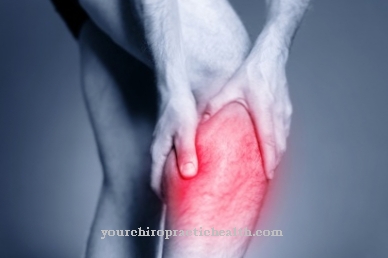Light bowel movements may or may not be due to an underlying medical condition. The color of the stool often depends on the food and can sometimes be a little lighter than usual. However, if the stool is permanently light colored, a doctor should be consulted.
What is pale stool?

Light-colored stool indicates either the absence of bile pigments or the presence of light-colored stool components. The dark red color of the stool is caused by a breakdown product of hemoglobin called Sterkobilin.
As an intermediate product of the breakdown of hemoglobin, bilirubin is initially formed, which is converted into its water-soluble form in the liver and released as a bile pigment via the bile to the intestine. The degradation of the bile pigment in Sterkobilin takes place in the intestine. The stool color therefore also depends on certain foods, among other things.
For example, meat rich in hemoglobin produces a particularly dark red color, while with a vegetarian diet the stool is often not so dark. A real deficiency in Sterkobilin and sometimes the presence of light-colored components in the stool often indicates health disorders or even more serious illnesses. Therefore, a permanently pale stool always requires a medical examination.
causes
The causes of light bowel movements are diverse and can be both harmless and more serious in nature. Even mild diarrheal diseases often lead to a light coloration of the stool, because the rapid passage through the intestine only allows a smaller proportion of bile pigments to get into the stool.
In addition, there may be an inflammatory swelling at the exit of the biliary tract, which often prevents normal bile from being released into the intestine. When the bile outflow into the intestine is disturbed by obstruction of the bile ducts with gallstones, constrictions and tumors, white to gray-white so-called ancholic stools are often produced. In the context of liver diseases, the formation of bile can be impaired.
Infectious liver diseases (all types of hepatitis) and liver damage from alcohol and drug abuse lead to white stools, dark urine and yellowing of the skin, the typical symptoms of jaundice.
Here the bile pigment is no longer excreted via the intestine, but gets into the blood and urine. Diseases of the pancreas often disturb the digestion of fat, so that high-fat light stools can occur. Furthermore, foci of pus often form in the case of intestinal infections, which sometimes ensure light stools.
You can find your medication here
➔ Medication for diarrheaDiseases with this symptom
- Biliary colic
- Gallstones
- Drug allergy
- Fat stool
- Liver disease
- hepatitis
- Pancreatic insufficiency
- Anemia
- Pancreatic cancer
Diagnosis & course
Home remedies ↵ for diarrhea Light-colored bowel movements are not a medical condition; they can be a symptom of an underlying medical condition. If chronic stool changes occur, it is important to seek advice from a doctor. The doctor can often make a suspected diagnosis as early as the anamnesis of the medical history.
It is important for him to know what other symptoms the patient is complaining about. Simultaneous darkening of the urine and yellowing of the skin indicates jaundice, which can be caused by diseases of the liver or gallbladder.
The doctor will also clarify which medication the patient is receiving and whether there is any alcohol abuse. If liver disease is suspected, blood tests will be carried out to determine liver values and any hepatitis viruses that may be present.
Stool exams can indicate bacterial bowel disease or pancreatitis. The use of imaging procedures, such as X-ray examinations, MRIs or colonoscopies, round off the examinations on the causes of pale stool.
Complications
The color, consistency, and frequency of bowel movements can change. We do not observe bowel movements in this country as intensely as other peoples and cultures do, which mostly also live in closer connection with nature. Light stools can indicate many things that can be quite harmless, but sometimes also require our attention. First of all, it can indicate a diet that is too high in fat, which does not immediately lead to further symptoms and complications, but can have considerable effects on our health in the long term.
These include, for example, coronary heart disease, obesity with all its consequences, and also a dull, worn-out, energy-free lifestyle in everyday life. Light stool also occurs in a number of gastrointestinal diseases, including chronic manifestations. It is often one of the first symptoms, but even if there are other signs besides pale stools, it is not always immediately recognized that there is a problem.
Other pathological causes that can be behind pale stools include various forms of hepatitis, intestinal tumors in the early to late stages, gallstones or pancreatitis. Even diarrhea with light-colored bowel movements can have pathological causes that require a more detailed examination by the doctor if the diarrhea occurs frequently. Occasional careful observation of the bowel movement could identify many diseases at an early stage and treat them well.
When should you go to the doctor?
Pale stools can be a temporary symptom of a change in diet or a sign of an illness that requires treatment by a doctor. When to see a doctor with pale stools depends in particular on the duration and severity of the symptoms.
The first step is to observe and analyze eating habits. If you eat little meat, a lot of dairy products and a lot of fiber, the light color of the bowel movements can possibly be explained by the diet.
If other symptoms occur, such as foul smelling urine, stomach pain or blood in the stool, a doctor must be consulted immediately. In such cases, it is usually a disease that requires therapy. Long-lasting, light-colored stools, even without secondary symptoms, should also be clarified medically.
A distinction must also be made between the exact color: a colorless, greyish-white bowel movement can be a symbol of a serious disease, such as a tumor or gallstones. A light yellow, on the other hand, can be explained by the use of medication or by diarrhea.
Doctors & therapists in your area
Treatment & Therapy
Therapy for pale stools depends on the cause. If the phenomenon occurs only briefly, no treatment is necessary. The cause here can be a brief intestinal infection or just the use of light-colored drugs such as antibiotics or magnesium supplements.
Certain foods with a high fiber content can also make the stool appear a little lighter. Liver diseases must be treated differently according to their cause. Some forms of hepatitis heal on their own. However, physical protection is crucial here. For chronic hepatitis B or hepatitis C, antivirals such as interferon are given.
Gallstones often need to be removed through surgery.Intestinal infections can be treated with antibiotics. In the case of unclear intestinal and pancreatic diseases, the cause must be further investigated. The symptoms here may be caused by autoimmune diseases, which requires appropriate drug treatment with immunosuppressants.
Sometimes, however, a long-term change in diet is enough to effectively combat the digestive disorders that cause light bowel movements.
Outlook & forecast
Pale stools are not always a sign of illness. Often times, changes in color and texture can be traced back to harmless causes such as diet or antibiotic use. Infants may have pale stools for no apparent reason.
If treatment is required, the prognosis depends on the cause and the patient's constitution. Gastrointestinal complaints can usually be treated without major complications, which should restore the stool to its original color. First and foremost is a change in eating habits, combined with sufficient physical activity. This naturally regulates the intestinal flora and the stool returns to its normal color. If the pale stool is caused by a disease of the gallbladder, an intestinal rehabilitation can alleviate the symptoms.
If left untreated, pale stools can cause complications. A postponed infectious disease can lead to dehydration, anemia and other complaints, which sometimes also worsen the general chances of recovery. Chronic bowel disease also rarely develops, and treatment can take months or years to develop. In principle, however, the prognosis for pale stools is positive.
You can find your medication here
➔ Medication for diarrheaprevention
Depending on the cause, there are ways to prevent pale stools. Eating a healthy diet can prevent many digestive problems. To avoid liver damage, alcohol and drug abuse should be avoided. Serious intestinal infections can be significantly limited by general hygiene measures, such as washing hands after using public toilets. However, there are also causes of pale bowel movements that preventive measures cannot prevent.
You can do that yourself
Various home remedies and measures can help with light bowel movements. If the altered stool is caused by a gastrointestinal disease, warmth is recommended, for example in the form of a cherry stone pillow or a hot water bottle. Herbal teas with chamomile or sage soothe the irritated intestines and promote blood circulation in the body.
In general, if your bowel movements change, you should pay attention to a balanced and healthy diet. Fatty or spicy foods should be avoided as well as alcohol, nicotine and caffeine. Dry bread and ginger (grated or as tea) regulate the bowel behavior and restore the natural color of the stool. The light-colored stool may also be caused by a certain drug or a pronounced plant-based diet - treatment is not always necessary here. However, if there is also flatulence or severe pain in the lower abdomen, a doctor should be consulted. In addition, a walk in the fresh air can stimulate digestion and thus alleviate the symptoms.
Anti-spasmodic drugs help with stomach cramps and pain during bowel movements. For example, poultices with sweet clover or potatoes as well as applications with cowslip and corn poppy or passion flower and Roman chamomile have proven effective. If the light stool persists for several days, a doctor should be consulted. There may be gallstones or some other serious cause that requires medical treatment.













.jpg)

.jpg)
.jpg)











.jpg)